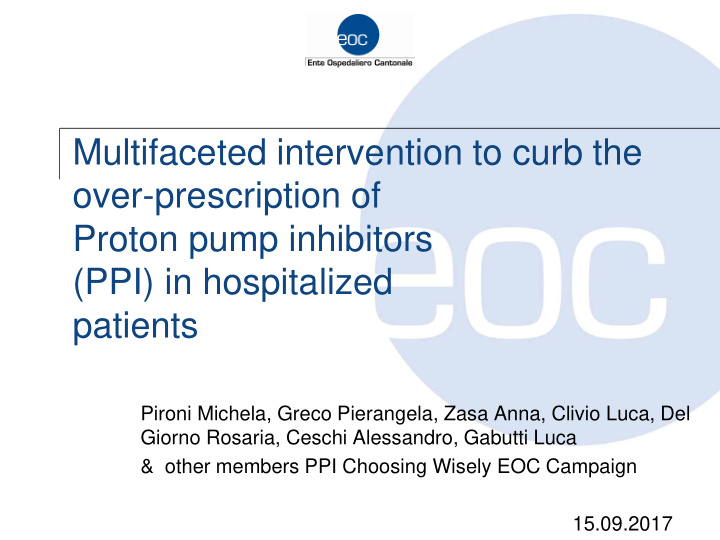



Multifaceted intervention to curb the over-prescription of Proton pump inhibitors (PPI) in hospitalized patients Pironi Michela, Greco Pierangela, Zasa Anna, Clivio Luca, Del Giorno Rosaria, Ceschi Alessandro, Gabutti Luca & other members PPI Choosing Wisely EOC Campaign 15.09.2017
Backround & Method Backround Aim To achieve a significant reduction of new PPI prescriptions at discharge in hospitalized patients by testing the efficacy of a multifaceted strategy consisting in: A continuos transparent monitoring-benchmarking system A capillary educational interventions (guidelines, presentations ,…) Method Multicenter longitudinal quasi-experimental before and after study, July 1 st 2014 to June 30 th 2017 ; 5 public teaching hospitals of the Italian- speaking region of Switzerland (Ente Ospedaliero Cantonale, EOC). Intervention Applied in the internal medicine departments. Primary outcome Reduction of PPI prescriptions at discharge. Control group: surgery departments of the same hospital network Simposio Choosing Wisely, 15.09.2017
Results 44’973 patients admission, collected on 36 months Internal Medicine Surgery Department Department Admissions (n.) 26.312 18.661 2.995 (11.4) 1.536 (8.2) H1, n (%) % of patients already taking H2, n (%) 4.975 (18.9) 3.273 (17.5) H3, n (%) 6.558 (24.9) 4.545 (24.4) PPI on admission: H4, n (%) 5.805 (22.1) 4.531(24.3) H5, n (%) 5.976 (22.7) 4.776 (25.6) Surgery wards: 23.3% Age, years (median, Q1-Q3) 75 (63-83) 67 (50-78) Age groups, n (%) 7.200 (27.4) 8.658 (46.4) Medicine wards: 44,9% <65, y 65-80, y 10.107 (38.4) 6.241 (33.4) >80, y 9.005 (34.2) 3.762 (20.2) 13.129 (49.9) 9.630 (51.6) Gender, females (%) Case-mix (median, Q1-Q3) 0.70 (0.51-0.92) 0.80 (0.53 -1.49) PPIs admission, n (%) 11.829 (44.9) 4.339 (23.3) PPIs discharge, n (%) 13.337 (50.7) 8.534 (45.7) Hospitals inter-variability: New PPI prescriptions, n (%) 2.617 (18.1) 4.696 (32.8) New PPI prescriptions by hospital high! H1, (%) 328 (12.5) 546 (11.6) 379 (14.5) 487 (10.4) H2, (%) Same hospital: similar trend in H3, (%) 747 (28.5) 1.316 (28.1) H4, (%) 481 (18.4) 772 (16.4) medical and surgical wards H5, (%) 682 (26.1) 1.575 (33.5) New PPI prescriptions by age groups, «Hospital trend»? n (%) <65, y 1.004 (38.4) 2.524 (53.7) 65-80, y 967 (36.9) 1.472 (31.4) 646 (24.7) 700(14.9) >80, y Simposio Choosing Wisely, 15.9.2017
Results Internal medicine wards: decreasing-trend of the annual rate of new PPI prescriptions: 19% (2014), 19% (2015), 18% (2016), and 16% (2017) (p<0.001year 2014vs. 2017; p-fortrend < 0.001). Surgery wards: increasing trend 30% (2014), 29% (2015), 36% (2016) and 36% (2017) (p<0.001, year2014vs.2017; p-for-trend<0.001). 36% 19% 16% 30% Simposio Choosing Wisely, 15.09.2017
Conclusion Design: Longitudinal quasi experimental before/after study (no RCT) but innovative! No data on PPI prescription indication We suppose decreasing trend means better appropriateness To confirm our hypothesis: ongoing data collection analyzing the PPI prescriptions appropriateness The introduction of a multifaceted intervention significantly reduced the trend of PPI prescriptions at hospital discharge in internal medicine departments. Further studies are needed to confirm if the strategy proposed could contribute to optimize the in-hospital drug prescription behavior in other settings as well. Simposio Choosing Wisely, 15.09.2017
Recommend
More recommend